

Natural Gas Pipeline Damaged by Construction Crew
This scenario is designed to help law enforcement personnel understand the initial response to a pipeline or natural gas release. Key areas include early recognition and identification of potential victims, and evacuation during a pipeline emergency.
Read Syllabus »This scenario is designed to help law enforcement personnel understand the initial response to a pipeline or natural gas release. Key areas include early recognition and identification of potential victims, and evacuation during a pipeline emergency.
Target Audience: Law Enforcement Police / Uniformed Personnel
Location: Suburban Community
Product: Flammable Gas
Pipeline: Distribution main line
Overall-Actions Stressed in Pipeline Emergency Response Guidelines (PERG)
Emergency Priority Goals
ICS Considerations:
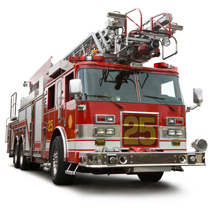
Transmission Line Break with Major Public Safety Issues
This scenario is designed to introduce Fire Department personnel to response goals and initial procedures in a natural gas or pipeline release. Activities include identifying a pipeline marker, determining basic clues for recognizing a release. The scenario also demonstrates how fire personnel can use the DOT Emergency Response Guide Book to determine initial safety zones and potential defensive actions in an emergency.
Read Syllabus »This scenario is designed to introduce Fire Department personnel to response goals and initial procedures in a natural gas or pipeline release. Activities include identifying a pipeline marker, determining basic clues for recognizing a release. The scenario also demonstrates how fire personnel can use the DOT Emergency Response Guide Book to determine initial safety zones and potential defensive actions in an emergency.
Target Audience: Fire Service
Location: City or larger suburban community
Product: Flammable Gas
Pipeline: Distribution main line
Overall-Actions
Emergency Priority Goals
ICS Considerations:
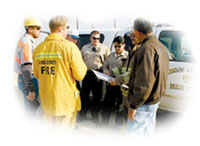
Liquid Pipeline Release with Major Environmental and Public Safety Impact
This scenario places emphasis on the immediate value gained when emergency response personnel, the pipeline operator and the community have prepared in advance to respond to a pipeline emergency. It reviews items such as hazard analysis, risk assessment, Incident Command, NIMS, and other assets and resources necessary for a safe response.
Read Syllabus »This scenario places emphasis on the immediate value gained when emergency response personnel, the pipeline operator and the community have prepared in advance to respond to a pipeline emergency. It reviews items such as hazard analysis, risk assessment, Incident Command, NIMS, and other assets and resources necessary for a safe response to a pipeline emergency.
Target Audience: First Responders, Community Officials and Pipeline Officials
Location: City/Community near a creek that flows to a river
Product: Flammable petroleum products
Pipeline: Transmission line (unknown release within the pipeline right-of-way)
Container: Pipeline
Overall Goals
Emergency Priority Goals
ICS Considerations:

Gathering / Transmission Line Failure
This scenario is designed to introduce Fire Department personnel to response goals and initial procedures in a natural gas pipeline release. Activities include identifying a pipeline marker and determining basic clues for recognizing a release. The scenario also demonstrates how fire personnel by using the DOT Emergency Response Guide Book can determine initial safety zones and potential defensive actions an emergency.
Read Syllabus »This scenario is designed to introduce Fire Department personnel to response goals and initial procedures in a natural gas pipeline release. Activities include identifying a pipeline marker and determining basic clues for recognizing a release. The scenario also demonstrates how fire personnel by using the DOT Emergency Response Guide Book can determine initial safety zones and potential defensive actions an emergency.
Target Audience: Fire Department
Location: Suburban Community
Product: Flammable Gas
Pipeline: Transmission line
Overall-Actions Stressed (P.E.R.G.)
Emergency Priority Goals
ICS Considerations:

"Traffic Safety" Officer at a Construction Site
This scenario is designed to aid security or law enforcement personnel to understand the response actions in a pipeline or natural gas release when they might be at a site or first on the scene in the early moments of the pipeline emergency. This scenario includes activities such as identifying a pipeline marker and recognizing indications of a release and using the DOT Emergency Response Guide Book or pipeline control center for guidance with evaluation and other initial response actions.
Read Syllabus »This scenario is designed to aid security or law enforcement personnel to understand the response actions in a pipeline or natural gas release when they might be at a site or first on the scene in the early moments of the pipeline emergency. This scenario includes activities such as identifying a pipeline marker and recognizing indications of a release and using the DOT Emergency Response Guide Book or pipeline control center for guidance with evaluation and other initial response actions.
Target Audience: Police Officers and Security personnel
Location: Suburban Community
Product: Flammable Gas
Pipeline: Distribution main line
Overall-Actions
Emergency Priority Actions
ICS Considerations:
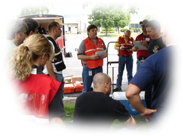
Highly Volatile Liquid Pipeline Release (LPG)
This scenario is designed to help emergency response personnel, the pipeline operator and the community understand the value of pre-planning its response to a pipeline emergency. It addresses emergency planning, pipeline locations, hazard assessment, Incident Command, and identification of potential hazards and risks in a pipeline emergency.
Read Syllabus »This scenario is designed to help emergency response personnel, the pipeline operator and the community understand the value of pre-planning its response to a pipeline emergency. It addresses emergency planning, pipeline locations, hazard assessment, Incident Command, and identification of potential hazards and risks in a pipeline emergency.
Target Audience: Police Officers Uniformed Personnel
Location: City Community Near railroad right of way
Product: Flammable Gas / LPG or Propane
Pipeline: Transmission Line within the right of way
Container: Pipeline
Overall-Actions Stressed (P.E.R.G.)
Emergency Priority Goals
ICS Considerations:

Gas and/or Pipeline Release for 911 Operators
Public safety answering points (PSAPs) and 911 operators typically are the first point of contact the public has in the emergency response system. Therefore, how the PSAPS and 911 operators receive and handle the calls can play a significant role in bringing the emergency to a successful conclusion. The decisions, communications and even the initial directions from the 911 operators can save lives.
Read Syllabus »Public safety answering points (PSAPs) and 911 operators typically are the first point of contact the public has in the emergency response system. Therefore, how the PSAPS and 911 operators receive and handle the calls can play a significant role in bringing the emergency to a successful conclusion. The decisions, communications and even the initial directions from the 911 operators can save lives.
Target Audience: PSAPs and 911 Operators Safety
Location: Any Community
Product: Natural Gas and/or Petroleum Products
Pipeline: Gas or Liquid
Overall Goals
Additional Relative Goal
The focus of Scenario #7 is for the PSAP and 911 operators to recognize that the actions taken during the first few minutes significantly impact the effectiveness of the response. PSAP and 911 operators are frequently the beginning of the response. They are the first personnel to begin the overall support of goals in all emergency response; achieving these goals is critical to the public’s safety:
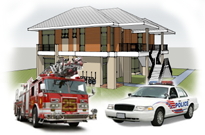
Gas Release in a Suburban Building
This scenario is designed to A natural gas leak inside a building is one of the most common emergencies responders face. This scenario will discuss natural gas escaping inside a building, which can lead to an explosion often with catastrophic results. Most emergency response actions taken at the natural gas emergency are the responsibility of the fire department. Law enforcement personnel, however, are typically the first to arrive on the scene. This scenario will focus on what actions any first responder should consider when responding to a natural gas emergency.
Read Syllabus »A natural gas leak inside a building is one of the most common emergencies responders face. This scenario will discuss natural gas escaping inside a building, which can lead to an explosion often with catastrophic results. Most emergency response actions taken at the natural gas emergency are the responsibility of the fire department. Law enforcement personnel, however, are typically the first to arrive on the scene. This scenario will focus on what actions any first responder should consider when responding to a natural gas emergency.
Target Audience: First Responders – Fire and/or Law Enforcement officers
Location: Suburban Community
Product: Natural Gas
Pipeline: Local Distribution Company
Overall Goals
Emergency Priority Goals
Other Considerations:
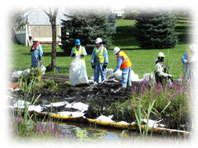
Hazardous Liquid Release Near Waterway
Cleaning up a pipeline spill has become an important concern because of recent occurrences around the United States. This scenario will familiarize responders with the hazards, risks, resources and tools necessary for controlling a liquid release on a waterway.
Read Syllabus »Cleaning up a pipeline spill has become an important concern because of recent occurrences around the United States. This scenario will familiarize responders with the hazards, risks, resources and tools necessary for controlling a liquid release on a waterway.
Target Audience: Community Officials / Senior Emergency Response Personnel
Location: Suburban Community Near River, Lake or Coastline
Product: Flammable Liquids / Crude
Pipeline: Transmission or Storage Leak
Container: (Pipe/Pressure) Undetermined
Overall-Actions Stressed (P.E.R.G.)
Emergency Priority Goals
ICS Considerations:
Copyright Pipeline Association for Public Awareness